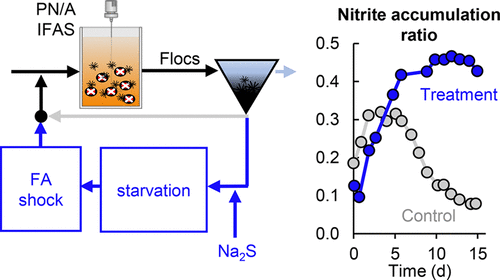当前位置:
X-MOL 学术
›
Environ. Sci. Technol.
›
论文详情
Our official English website, www.x-mol.net, welcomes your
feedback! (Note: you will need to create a separate account there.)
Synergistic Exposure of Return-Sludge to Anaerobic Starvation, Sulfide, and Free Ammonia to Suppress Nitrite Oxidizing Bacteria
Environmental Science & Technology ( IF 10.8 ) Pub Date : 2018-07-16 , DOI: 10.1021/acs.est.7b06591 Dries Seuntjens 1 , Michiel Van Tendeloo 1, 2 , Ioanna Chatzigiannidou 1 , Jose Maria Carvajal-Arroyo 1 , Sander Vandendriessche 1 , Siegfried E. Vlaeminck 1, 2 , Nico Boon 1
Environmental Science & Technology ( IF 10.8 ) Pub Date : 2018-07-16 , DOI: 10.1021/acs.est.7b06591 Dries Seuntjens 1 , Michiel Van Tendeloo 1, 2 , Ioanna Chatzigiannidou 1 , Jose Maria Carvajal-Arroyo 1 , Sander Vandendriessche 1 , Siegfried E. Vlaeminck 1, 2 , Nico Boon 1
Affiliation

|
A key step toward energy-positive sewage treatment is the development of mainstream partial nitritation/anammox, a nitrogen removal technology where aerobic ammonium-oxidizing bacteria (AerAOB) are desired, while nitrite-oxidizing bacteria (NOB) are not. To suppress NOB, a novel return-sludge treatment was investigated. Single and combined effects of sulfide (0–600 mg S L–1), anaerobic starvation (0–8 days), and a free ammonia (FA) shock (30 mg FA-N L–1 for 1 h) were tested for immediate effects and long-term recovery. AerAOB and NOB were inhibited immediately and proportionally by sulfide, with AerAOB better coping with the inhibition, while the short FA shock and anaerobic starvation had minor effects. Combinatory effects inhibited AerAOB and NOB more strongly. A combined treatment of sulfide (150 mg S L–1), 2 days of anaerobic starvation, and FA shock (30 mg FA-N L–1) inhibited AerAOB 14% more strongly compared to sulfide addition alone, while the AerAOB/NOB activity ratio remained constant. Despite no positive change being observed in the immediate-stress response, AerAOB recovered much faster than NOB, with a nitrite accumulation ratio (effluent nitrite on nitrite + nitrate) peak of 50% after 12 days. Studying long-term recovery is therefore crucial for design of an optimal NOB-suppression treatment, while applying combined stressors regularly may lead toward practical implementation.
中文翻译:

回流污泥对厌氧饥饿,硫化物和游离氨的协同暴露以抑制亚硝酸盐氧化细菌。
积极处理污水的关键步骤是开发主流的部分硝化/厌氧氨氮技术,这是一种氮去除技术,其中需要有氧铵氧化细菌(AerAOB),而不需要亚硝酸盐氧化细菌(NOB)。为了抑制NOB,研究了一种新型的污泥回流处理方法。硫化物(0–600 mg SL –1),无氧饥饿(0–8天)和游离氨(FA)休克(30 mg FA-N L –1)的单一和综合作用持续1小时)进行了即时效果和长期恢复的测试。AerAOB和NOB立即被硫化物按比例抑制,AerAOB可以更好地应对这种抑制作用,而短暂的FA休克和厌氧饥饿的影响较小。联合作用更强烈地抑制AerAOB和NOB。硫化物(150 mg SL –1),无氧饥饿2天和FA休克(30 mg FA-N L –1)的综合治疗)与单独添加硫化物相比,对AerAOB的抑制作用强14%,而AerAOB / NOB活性比保持恒定。尽管在即时压力反应中未观察到任何积极变化,但AerAOB的恢复速度远快于NOB,在12天后亚硝酸盐累积比率(亚硝酸盐+亚硝酸盐+硝酸盐流出的亚硝酸盐)达到50%的峰值。因此,研究长期恢复对于设计最佳的NOB抑制治疗至关重要,而定期应用组合压力源可能会导致实际应用。
更新日期:2018-07-18
中文翻译:

回流污泥对厌氧饥饿,硫化物和游离氨的协同暴露以抑制亚硝酸盐氧化细菌。
积极处理污水的关键步骤是开发主流的部分硝化/厌氧氨氮技术,这是一种氮去除技术,其中需要有氧铵氧化细菌(AerAOB),而不需要亚硝酸盐氧化细菌(NOB)。为了抑制NOB,研究了一种新型的污泥回流处理方法。硫化物(0–600 mg SL –1),无氧饥饿(0–8天)和游离氨(FA)休克(30 mg FA-N L –1)的单一和综合作用持续1小时)进行了即时效果和长期恢复的测试。AerAOB和NOB立即被硫化物按比例抑制,AerAOB可以更好地应对这种抑制作用,而短暂的FA休克和厌氧饥饿的影响较小。联合作用更强烈地抑制AerAOB和NOB。硫化物(150 mg SL –1),无氧饥饿2天和FA休克(30 mg FA-N L –1)的综合治疗)与单独添加硫化物相比,对AerAOB的抑制作用强14%,而AerAOB / NOB活性比保持恒定。尽管在即时压力反应中未观察到任何积极变化,但AerAOB的恢复速度远快于NOB,在12天后亚硝酸盐累积比率(亚硝酸盐+亚硝酸盐+硝酸盐流出的亚硝酸盐)达到50%的峰值。因此,研究长期恢复对于设计最佳的NOB抑制治疗至关重要,而定期应用组合压力源可能会导致实际应用。











































 京公网安备 11010802027423号
京公网安备 11010802027423号